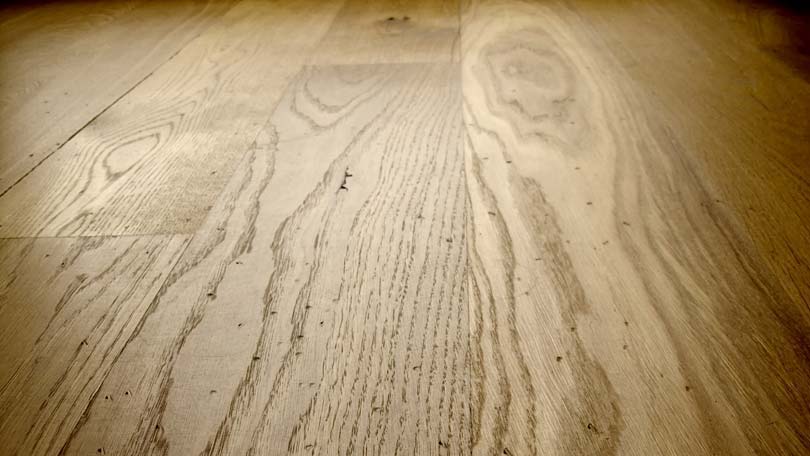
There’s a newfound interest in the antique, and in flooring it seems that “Everything old is new again.” Hand-scraped flooring leads the way in this new trend toward incorporating the rustic, or old-style into home design.
Hand-scraping was originally done in the pre-power tool days, on-site, after the rough floor had been laid. Workers used draw knifes to smooth out the rough saw marks on the planks and create a comfortable walking surface. But of course, without fine milling and sanding, the hand-scraping left a distinctively grooved surface, that although smooth to the touch, features ridges and grooves left from the knife.
Shedding their rustic past like a winter coat, Americans were only too happy to migrate to machine milled floors as they became available, thus relegating hand-scraped flooring to the more rural, remote outposts. In time, the uniformity of 2 ¼” width boards and shiny-smooth finish floors became boring, and folks started to look for “new” alternatives. In recent years we’ve seen a comeback of wide plank floors, top nailed or pegged floors, rough-sawn, and hand-scraped flooring material.
Another trend that is complementing this return to the past is the actual recycling of antique wooden beams, lumber and flooring into modern flooring material. The lumber is harvested from old buildings, barn and factories, then de-nailed, and milled into tongue and groove flooring or used as the top laminate in modern, engineered floors. The tongue and groove boards are the standard, traditional nail down type, while engineered flooring offers nail down, glue down, snap and lock floating installation methodologies. The advantage to using this antique wood is the rich aging and patina that the wood exhibits. In some cases, it’s the only way to use extinct or rare species such as American Elm and American Chestnut. And, as you might expect, recycled flooring is available with hand-scraped finishes also.
Man Versus Machine
While there are many floors being labeled “Hand-Scraped”, that may describe the look, but not the actual process. Most new hand-scraped flooring is actually milled to recreate the look of hand-scraping. It looks rather good, and has a nice tactile feel to the surface, but critics cite its uniformity – the patterns repeating – as a drawback. You’ll see this more in the darker finished woods, and less so in the lighter finishes. The advantage, of course, is the low cost of machine finishing, compared to actual labor costs to hand scrape individual floorboards. The advantage to the actual hand-scraped floor is the unique, distinct, and truly hand-crafted look of the floor.
Where to Find Hand-Scraped Flooring
When looking for hand-scraped floor ideas, try looking around fancier retail establishments, such as high-end clothing stores, restaurants, and wine bars. Oftentimes, suburban malls features this kind of establishment, and you can get loads of ideas before heading the neighborhood big home retailer for more sleuthing. At these big box store, you’ll find many different options in hand-scraped flooring from different suppliers. Be sure to find the most knowledgeable salesperson there (preferably a retired installer!) and ask lots of questions about installation, wear, refinishing, warranty, etc. Remember, this is potentially a 20 – 50 year purchase!
After you’ve seen the big box offerings, get over to one or two custom flooring places where you can see actual hand scraped flooring. You’ll see a difference for sure, but the question be whether it’s worth paying for? Again, pepper the salesperson with questions, don’t be shy, you’re on a mission to make an informed purchasing decision. There can be differences in texture between manufacturers, so compare them side-by-side. Find out where the flooring is made, as some of the offshore product hasn’t been up to par with domestic flooring. Ask if you can see some installations of your top choices, as it’s sometimes helpful to see an entire floor, rather than a small sample.
Pre-finished or Finish it Yourself
Most modern hand-scraped flooring comes as engineered, pre-finished, so you simply install and you’re all set. Other flooring comes unfinished, requiring some work on your part. Naturally sanding is out of the question, as it erases all that character you’ve paid for. Many opt for the “hand rubbed” finish that complements the texture nicely with its softer appearance. Rubbing the finish in takes advantage of the high and low spots, and creates a subtlety varied surface of light and dark tones. You may want to investigate some of the oil finishes such as tung oil for a nice, warm appearance.
A Floor of Distinction
Once you’ve compared hand-scraped flooring against traditional, smooth-finished flooring, you’ll understand the visual and tactile appeal. But remember there are other options, too, for adding distinction to your flooring project. Distressed wood, for example, offers random dents, bruises, and “wear” marks that mimic and old, well-worn floor. Top nailing or “pegging” your floors also adds a great, antique look. And a good custom finish, on top of a smooth unfinished wooden floor, using light and dark stains, can create a rich, highly varied appearance, with darker edges and bevels, and a lighter surface area. We’d recommend that you experiment with some finishing techniques “offline” – with scrap pieces – before you go “online” and start finishing your new floor.
The beauty of hand-scraped flooring is highlighted by natural light, so consider it for installations in sunny, well-lit areas such as living rooms, family rooms, and bright kitchens. Think about orienting the boards running into the light – toward the windows – to accentuate the linear texture of the wood, and to bring the light into the room.
